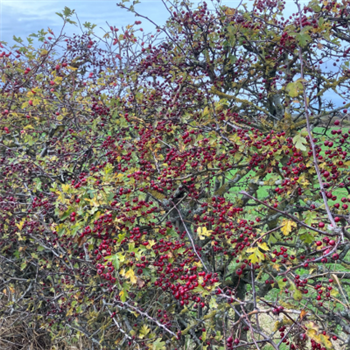A Ranger Writes: Heroic hedgerows
 Our Countryside Rangers have a wealth of knowledge on the places, plants and species that call East Lothian home. Ranger Richard English celebrates hedges: the unsung hero of the countryside
Our Countryside Rangers have a wealth of knowledge on the places, plants and species that call East Lothian home. Ranger Richard English celebrates hedges: the unsung hero of the countryside
As we move into November, Autumn is in full swing and winter is just around the corner (sorry). What better time to celebrate one of the countryside’s unsung heroes; a tree, or shrub if you prefer, that’s so common and ubiquitous that it often gets taken for granted?
Common hawthorn (Crataegus monogyna) is a member of the rose family found throughout the UK, Europe, western Asia and North Africa. It can reach up to about 10 metres in height, although many individuals are considerably shorter than this. The tree produces white or pink flowers in late spring – usually in May, hence its alternative name of the May tree. At this time of year, the dark green leaves will be fading to yellow-brown, or will have fallen, but the hawthorn will still carry many of its distinctive red berry-like fruits – the haws that give it its name.
Important food source
The haws are not the juiciest of fruits but are still an important food source for birds and small mammals. They are particularly prized by winter visitors such as fieldfare, redwing and waxwing. In addition, hawthorn provides food and shelter for hundreds of invertebrate species; the leaves are eaten by the caterpillars of several moth species and the flowers supply nectar to bees, flies and other pollinators. Unsurprisingly, given its name, the hawthorn shieldbug is very closely associated with the tree. This insect is a striking green and red beastie, the shape of which resembles a medieval shield. As if that wasn’t enough wildlife, the hawthorn’s dense foliage also offers excellent shelter for nesting birds.
The hawthorn has long been valued in the countryside for its value as a hedge species. Not only does it adapt well to traditional hedge-laying techniques, but its dense branches and sharp thorns make it ideal for stock-proof barriers. Hedges are an incredibly valuable feature of the landscape. Not only do they provide food and shelter for wildlife, but they also form “green corridors” between habitats which might otherwise be completely isolated from each other.
Protection against vampires!

Away from hedges, hawthorn can be found in woodland and scrub habitats. Scrub is that messy, shrubby habitat type that gradually takes over from unmanaged grassland; and is, in turn, usually succeeded by woodland. Hawthorn is a vital component of such habitats and is often one of the first tree species to colonise these areas.
Perhaps not surprisingly for a species often found, or indeed planted, close to human settlements hawthorn has plenty of associated folklore. It was long used by herbalists to treat heart conditions, but was conversely often linked to death and specifically the Plague. This latter may be connected to a smelly chemical, trimethylamine, found in hawthorn blossom but also as a product of decay in corpses. In central Europe hawthorn was valued as a protection against vampires – always a good thing, you’d imagine.
 A haw shieldbug: credit Richard Croft (geograph.org.uk)
A haw shieldbug: credit Richard Croft (geograph.org.uk)
Keep up to date
Keep up to date with all things Countryside Ranger on the service’s facebook or Instagram pages. You’ll find news and information to help you make the most of your time in our coast and countryside spaces as well as beautiful photography of the species that live here.
Facebook: @ELCrangers
Instagram: @elcrangers